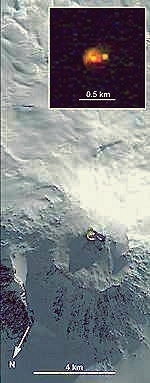
 Mount Erebus Caught in the Act. A new Jet Propulsion Laboratory (JPL) device might equip future Earth-orbiting spacecraft. The Autonomous Sciencecraft Experiment (ASE) is allowing Earth-observing satellites to make decisions on their own, catching events scientists would need months to observe, or would never be able to. The Earth Observing-1 (EO-1) spacecraft was using this new concept when it flew above Mount Erebus, Antarctica, last May, 7th 2004. As the craft detected a significant amount of heat coming out from the lava lake at the volcano's summit, it instantaneously took pictures of the event, realizing Mount Erebus was active. Pictures were immediately transmitted Earth. The ASE is allowing satellites to make decisions on the fly, based on data detected by their sensors, with a reprogramming ability further extending the craft ability to study short-lived events. The technique might further be used to spot natural disasters like flooding or fires ahead of any danger posed to populated areas. See how the lava is glowing atop the volcano (the most recent software upgrade allows the spacecraft to accurately recognize cryosphere changes such as ice melting and to identify types of clouds. It might be used further in the frame of planetary missions, to study dust storms at Mars, ice volcanoes at Jupiter's Europa, or volcanism at Io)
Mount Erebus Caught in the Act. A new Jet Propulsion Laboratory (JPL) device might equip future Earth-orbiting spacecraft. The Autonomous Sciencecraft Experiment (ASE) is allowing Earth-observing satellites to make decisions on their own, catching events scientists would need months to observe, or would never be able to. The Earth Observing-1 (EO-1) spacecraft was using this new concept when it flew above Mount Erebus, Antarctica, last May, 7th 2004. As the craft detected a significant amount of heat coming out from the lava lake at the volcano's summit, it instantaneously took pictures of the event, realizing Mount Erebus was active. Pictures were immediately transmitted Earth. The ASE is allowing satellites to make decisions on the fly, based on data detected by their sensors, with a reprogramming ability further extending the craft ability to study short-lived events. The technique might further be used to spot natural disasters like flooding or fires ahead of any danger posed to populated areas. See how the lava is glowing atop the volcano (the most recent software upgrade allows the spacecraft to accurately recognize cryosphere changes such as ice melting and to identify types of clouds. It might be used further in the frame of planetary missions, to study dust storms at Mars, ice volcanoes at Jupiter's Europa, or volcanism at Io)
picture courtesy NASA
Website Manager: G. Guichard, site 'Amateur Astronomy,' http://stars5.6te.net. Page Editor: G. Guichard. last edited: 12/28/2010. contact us at ggwebsites@outlook.com

